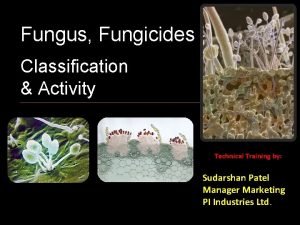Fungicide Sensitivity of Sclerotinia sclerotiorum Isolates Selected from

- Slides: 1

Fungicide Sensitivity of Sclerotinia sclerotiorum Isolates Selected from Five Different States That Use Different Fungicide Treatments Cristian Wulkop, Sydney Everhart Summary Department of Plant Pathology EC 50(D) Determination Methods Introduction • Sclerotinia sclerotiorum is a plant pathogen responsible for $252 M in losses every year. Resistance to the most effective fungicides has emerged and spread in pathogen populations. Methods • S. sclerotiorum isolates are inoculated in fungicide amended plates. Growth is measured after 30 hours. EC 50(D) is calculated. Contact: cristianwulkop@huskers. unl. edu • The EC 50 is the concentration of a fungicide that gives the half maximal response on a fungal pathogen. Selection of Isolates • For this study, we will be calculating the EC 50(D) by measuring • This study examines 95 isolates from dry bean fields from percent growth on plates amended with a discriminatory five states of the United States: North Dakota (32), concentration previously determined by members of the Colorado (28), Nebraska (11), Washington (20), Michigan (4). Everhart Lab. Results • No differences in EC 50(D) found between groups screened against Bscalid. • Baseline and Washington isolates have a significantly higher EC 50(D) than Nebraska isolates screened against tetraconazole. • Washington, Michigan, and Baseline isolates have a significantly higher EC 50(D) than Nebraska isolates screened against picoxystrobin. Boscalid Fungicide: Succinate Dehydrogenase Inhibitor Conclusions • Differences in EC 50(D) in different states hints at S. sclerotiorum developing resistance to commonly used fungicides. Background • Sclerotinia sclerotiorum is a plant pathogenic fungus that can cause a disease called white mold that can infect more than 450 plant species including soybeans, dry beans, green beans, canola, and sunflower • Estimated to cause $252 M in losses every year to disease U. S. Canola Association 2014 Figure 1. Common symptoms of white mold, the disease caused by S. sclerotiorum Figure 2. Map showing the geographic location of the five states the isolates of this study were collected from. It also show the number of isolates from each state. • Isolates were selected in an attempt to represent as many fields from the five states selected from the selection of isolates in the Evertart lab, while still having a significant amount of isolates present from each field. Figure 6. Estimated EC 50(D) from isolates against Boscalid fungicide • Very good control; no differences found between groups Tetraconazole Fungicide: Demethylation Inhibitor Reactivating Sclerotia • Sclerotia are hard dark resting bodies of fungi that can remain dormant for long periods • Sclerotia are treated with bleach and inoculated in water agar plates to induce mycelial growth Figure 3. Picture of S. sclerotiorum sclerotias. • Fungicides are widely used in developed agricultural systems to control Inoculation of PDA Plates • Plugs of the mycelial growth are transferred into control disease and safeguard crop yield and quality and fungicide amended PDA plates • Resistance to the most effective fungicides has emerged and spread in • Boscalid, Tetraconazole, Picoxystrobin fungicides were pathogen populations Lucas 2015 used in this study at the discriminatory concentration of • There have been multiple reports of S. sclerotiorum isolates from dry 0. 2 ppm, and 0. 01 ppm, respectively. bean, soybean, and canola fields being resistant to certain fungicides. • Radial growth in two perpendicular directions was Lehner et al. 2015 measured after 30 hours • Figure 7. Estimated EC 50(D) from isolates against Tetraconazole Fair control; Baseline and Washington isolates have a fungicide significantly higher EC 50(D) than Nebraska isolates Picoxystrobin Fungicide: Quinone Outside Inhibitor Figure 4. S. sclerotiorum isolate’s growth after 30 hours under control treatment Figure 5. S. Sclerotiorum isolate’s growth after 30 hours under Boscalid fungicide treatment Conclusions & Future Directions • Differences in EC 50(D) in different states hints at S. sclerotiorum developing resistance to commonly used fungicides. • The data shows a significant difference between the EC 50(D) of Nebraskan isolates compared to baseline isolates and Washington, Michigan, and baseline isolates against tetraconazole and picoxystrobin, respectively. • Further studies or surveys must be done to assess the differences between the treatments of dry bean fields in different states. This would allow investigation into whether differences in fungicide sensitivity are caused by natural selection driven by the application of fungicides. • Once this is done, some recommendations on fungicide applications for farmers can be developed in order to stop the spread of fungicide resistance. • In the future, we will be genotyping the least sensitive (like resistant) isolates to check for single nucleotide polymorphisms (SNPs) that are related to the lack of sensitivity. Acknowledgements • Rebecca Higgins • Sydney Everhart • Edgar Nieto-Lopez • UCARE • Institute of Agriculture and Natural Resources References Hypothesis Since different fields in different states use different fungicide treatments on plants and different numbers of application depending on environmental conditions, isolates with the lowest fungicide sensitivity will be those that come from fields with more intensive fungicide applications. Goal: Determine the fungicide sensitivity of S. sclerotiorum isolates from five states to assess risk of resistance • These are preliminary results from the first experimental replica of the project. The second experimental replica has now been completed along with the screening of a fourth fungicide, thiophanate methyl. However, due to time constraints, the statistical analysis of this data has yet to be performed. Figure 8. Estimated EC 50(D) from isolates against Picoxystrobin fungicide • Very good control; Washington, Michigan, and Baseline isolates have a significantly higher EC 50(D) than Nebraska isolates. 1. U. S. Canola Association. National Sclerotinia Initiative. Retrieved from http: //www. uscanola. com 2. Lucas JA, Hawkins NJ, Fraaije BA (2015). Chapter Two – The Evolution of Fungicide Resistance. Advances in Applied Microbiology 90: 29 -92 3. Lehner MS, Paula Júnior TJ, Silva RA, Vieira RF, Carneiro JES, Schnabel G, Mizubuti ESG (2015) Fungicide sensitivity of Sclerotinia sclerotiorum: a thorough assessment using discriminatory dose, EC 50, high-resolution melting analysis, and description of new point mutation associated with thiophanatemethyl resistance. Plant Dis 99: 1537– 1543

